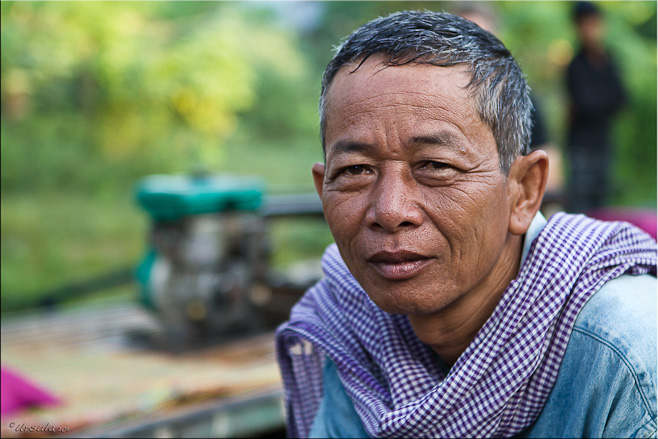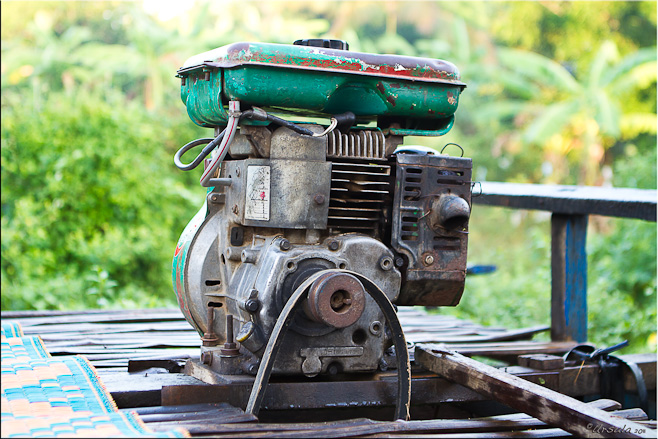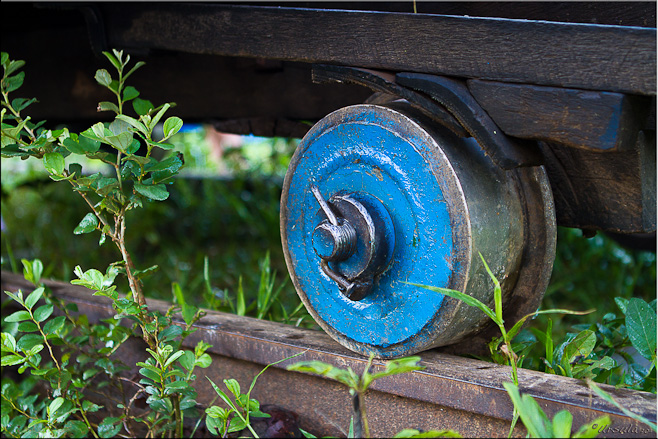
Driver ~ Bamboo Train
Take isolated communities growing rice and raising cows and chickens in rural Cambodia where few roads reach, and you have a need. Take some rail track in disrepair, a bamboo raft and a small motor and you have a solution.
Meet “The Bamboo Railway”: the ear-splitting, bone-rattling, wind-in-your-hair, bushes-in-your-face solution to transporting goods and people from Battambang to points south and back again.

The "Norry" or Bamboo Rail Car is Powered by a Small Motor

Metal Wheels on the Rail Line

Holding the whole thing together with bent metal rail ties...

The Smoking Man: Our Driver is a Cool Dude
During their colonial rule, the French put 400 miles of rail line across Cambodia, but the years of war, civil war, and general instability since they departed the country in 1953 have taken their toll. Although the Khmer Rouge were overthrown by the Vietnamese in early 1979 after a four-year reign of terror, they continued to wage guerrilla war throughout the country into the late 1990s, making the railway one of their targets. They planted land mines along the rail lines (and elsewhere, of course) and frequently ambushed trains. Conventional trains have run only irregularly for years, and passenger trains stopped completely over a year ago. Since the first rails were laid in the 1920s, ingenious locals have braved the hazards of oncoming locomotives and potential mines to use the lines to advantage.
Our trip to the railway had been organised by our able photo-tour/workshop leader Karl Grobl. We left our comfortable beds at our delightful hotel in Battambang at six am – that’s six am – and climbed into local tuk-tuks to arrive at the local ‘train station’ – a loose collection of bamboo and wooden buildings on a dusty road – in time to watch the ‘norries’, or rail-riding platforms, be put together. It’s simple really: lift two metal wheels welded to an axle wide enough to fit the rails onto the track in pairs. Rest a bamboo platform on top. Fix a small motor to the rear axle with a fan belt that passes through a hole in the bamboo, and you are set. Passenger ‘norries’ come with a cushion for comfort – if you are lucky.

All you need is a small motor, a fan-belt and a little push, and you are off!

Speed! We rattled and bumped, being whacked by bushes, at speeds of up to 50km/hour.

As rail lines weave and wobble toward the norry in the distance, goods wait at the side of the track.

Endless rice patties, Battambang Province
Apparently, you can ride bamboo trains all the way to Phnom Penh. I have no idea how far we went because none of the ‘towns’ we stopped were signposted in English, and I know they are not on my map. We bumped past countryside uninterrupted by roads, enjoying the cooling wind in the already hot, humid morning and getting a wonderful view into a world less-travelled by tourists. Everywhere we stopped, people were happy to come out to greet us, and to allow us to photograph daily life.

A kitten and her friends welcome us to some small hamlet in Battambang Province

Light ~ Dark ~ Heat : Bringing in the Rice

Washing the Morning Dishes

This woman keeps the accounts at the local rice storage shed.

Piled Passengers in a Tractor Transport

Small Town Shopkeepers

Roadside Laundry. Note the glass bottles of gasoline/petrol behind her.

Hulling the Rice Harvest

Local Barber Shop
To accommodate two-way traffic on a single line, Norry courtesy dictates that when two carriages meet, the one with the lighter load leaves the track. Drivers and passengers pitch in to disassemble and reassemble the norries to allow passage. This process was surprisingly quick.

"Incoming!" An over-loaded norry gets right of way...

The lighter load stands aside, off the tracks, to allow passage.

Tourist norries are easy to off-load, as there is nothing on them but people!

Rebuilding the norry takes only a few moments.

No whistle... No bell... The only choice is to wait until the cows wander off...

"Don't look down!"
The Bamboo Railway is technically illegal, and clearly there is no Occupational Health and Safety committee supervising its operation! There is rumour that the rail line is going to be repaired and ‘proper’ trains will run again. But, this is Cambodia, and these things take time…. Until the repairs happen, the norries and their resourceful drivers are filling a local need and bringing in tourist dollars.

Riding the Rails!
I had a wonderful morning ‘riding the rails’, but as soon as we stopped moving, the heat and humidity enveloped us like a fog. I had to keep reminding myself that it wasn’t yet 8:30am. The six am start to our day was starting to make sense, and I could only sympathise with those who had to ride the bamboo rails through the midday heat.
 Until next time, stay cool and travel safe!
Until next time, stay cool and travel safe!




























.jpg)


what an amazing exitence…what amazing people
Hi Signe,
Quite something, isn’t it? Sorry to not be there on time for your Friday morning!! Had a really busy week. 😉
[…] has written a terrific blog about the train and our morning – please check it out . . . https://www.ursulasweeklywanders.com/travel/riding-bamboo-rails-the-bamboo-train-battambang-cambodia/. Battambang Bamboo Train Battambang Bamboo Train – Life Along the Tracks Battambang Bamboo Train – […]
You have really interesting blog, keep up posting such informative posts!
[…] For additional images and information about the bamboo train, you might enjoy these two other blog posts; the first from a 2010 blog post here and another from 2011 Angkor Photo Workshop participant Ursula Wall, which can be seen by clicking here. […]
[…] For more information about the Bamboo Train, click the link to a story by 2011 Angkor Photo Workshop participant Ursula Wall. […]
[…] Riding Bamboo Rails (Ursula Wall) […]